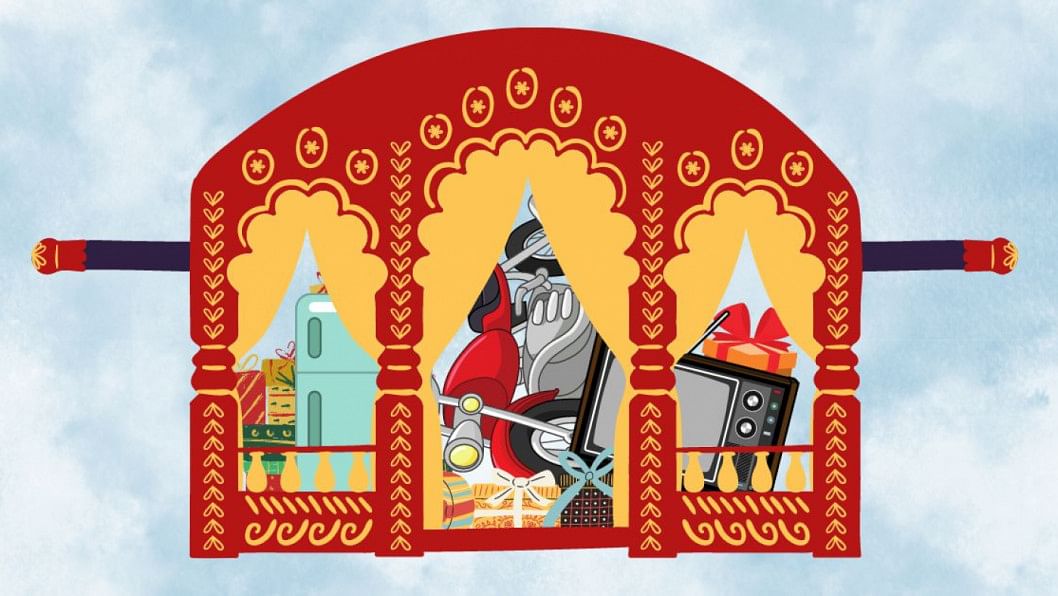Dowry still exists in the guise of ‘gifts’

Recently, we came across a father from a remote village in Khulna whose daughter was about to get married, and asked him whether he had been asked to pay dowry. He vehemently denied so, but then we learnt that he had gotten a sizeable bank loan against his sole land plot as collateral, to pay for "gifts" for his daughter. He tried to convince us that the groom's family had not demanded such gifts, so they were not dowry.
Simply put, this silent tradition of parents/guardians giving "gifts" at weddings – sometimes at exorbitant costs – is getting ingrained in our society. We now accept dowry in the guise of said "gifts" or "presents."
The value of these so-called gifts is occasionally the same as – or even more than – the assets sold or mortgaged to pay for them. The asset loss due to dowry pushes poor families further into financial insecurity and/or poverty. Added to this are the cases of domestic violence due to dowry that are still being reported. According to a survey conducted in 2018, 15 percent of women are abused for dowry; the actual number of such cases is likely to be much higher as these incidents often go unreported. Interestingly, news reports of dowry-driven violence cases have been declining since 2015. Does that mean we are heading towards a dowry-free future?
The answer to that question is not pleasant, especially when we dig into the transformation of this practice in rural Bangladesh. To combat the newly-established form of dowry, conventional routes of criticism, awareness-building and law enforcement probably won't work as effectively. This is because in this system, victims are untraced, no complaints are filed, and the so-called gifts are accepted by the groom and willingly supplied by the bride's family.

Empirically, we found that both the bride and groom's families know that dowry is illegal and a punishable offence. Nevertheless, under the guise of gift-giving, the practice still goes on, aiming to keep the groom's family happy to ensure the bride's future security, as observed in the chars of Sirajganj, Kurigram, Rangpur, Khulna and Satkhira. The key knowledge gap, in this case, is that the gift suppliers are ignorant about Section 3 of the Dowry Prohibition Act, 2018, which states that "…any direct or indirect demand for dowry by either party from the other will be an offence under the law. Such offence shall be punishable with imprisonment (of) maximum five years but not less than one year…"
One of the less-discussed aspects of this form of dowry is the fear of extreme poverty and homelessness caused by climate shocks (cyclones, heavy rainfall, flood and river erosion) in the coastal and northern parts of the country. This threat is driving many families to marry off their young daughters, and dowries are a major catalyst in these marriages.
Surprisingly, in the current system, the demand for dowry remains silent from the groom's side. They confidentially communicate the demand via the matchmakers, who play a prominent role in driving up dowry, in whatever shape or form. The matchmakers influence the bride's family to showcase their affluence and social standing through luxurious gifts. They manoeuvre the bride's family, assuring them that the groom's family has no asset or cash demands. The two sides, thus, avoid embarrassment and potential legal liability, but the bride's family is somehow persuaded to give lucrative gifts – a gift-free marriage causes fear of embarrassment in society.
Social pressure thus plays a critical role in compelling the bride's family to give gifts (dowry) at any cost. Sociologist Shahana Nasrin, in her book Crime or Custom, termed hypergamy as one of the key reasons for dowry. The bride's family thinks that marrying off their daughter with a socially esteemed groom would naturally be costly. Therefore, under external pressure – from distant family, neighbours and matchmakers – the bride's family takes up the financial burden.
The commonplace approach to uprooting dowry may not be effective because of its changed form. To obliterate the scourge of such silent dowry, careful investigations are needed. The foremost policy measure can be a nationwide campaign to raise awareness about the law and what it entails. The right definition of dowry, demonstration of such silent dowry practice and its retribution in rural gatherings, its form, and the associated punishment, should be communicated to the masses.
The inclusion of the definition, nature and causes and effects of dowry in textbooks and classroom lectures can slowly alter the attitudes of today's children and youth, who can then bring about an intergenerational shift that will help purge dowry of all shapes and forms from society. Empowering women, albeit a visionary and challenging goal, can boost their decision-making power and economic security, which may help reduce the occurrence of dowry. Targeting changes in attitudes and strong moral standing to get rid of this practice for good is the only way out.
Md Karimul Islam and Dipika Biswas are research associates at Brac Institute of Governance and Development (BIGD), Brac University.

 For all latest news, follow The Daily Star's Google News channel.
For all latest news, follow The Daily Star's Google News channel. 









Comments